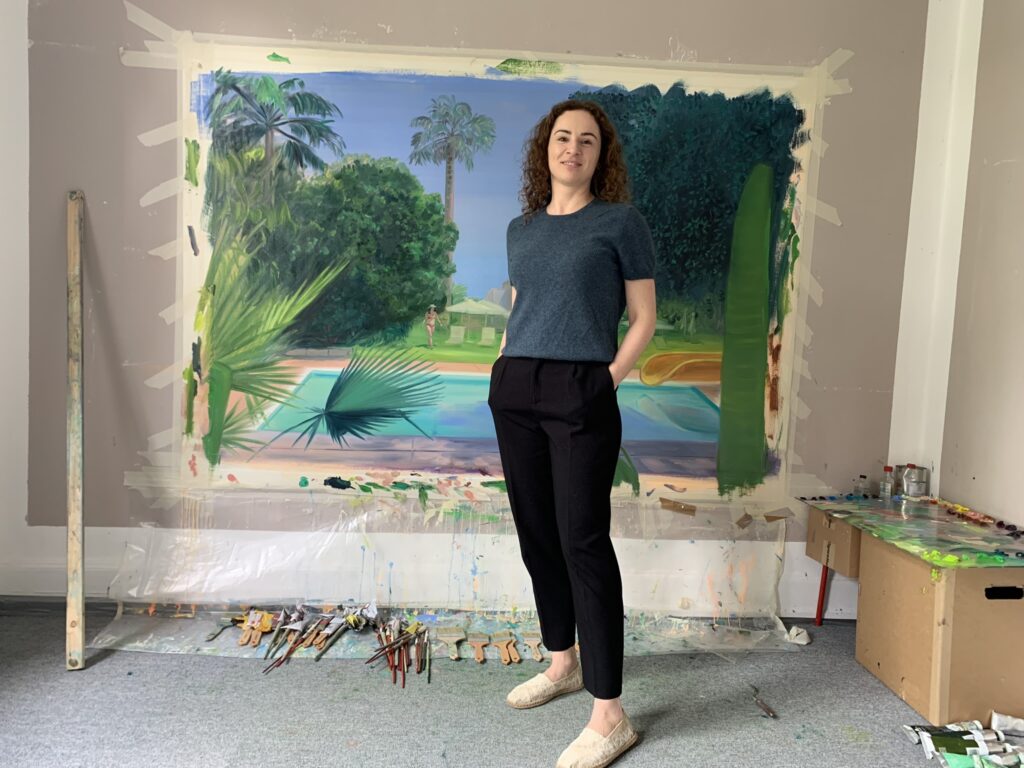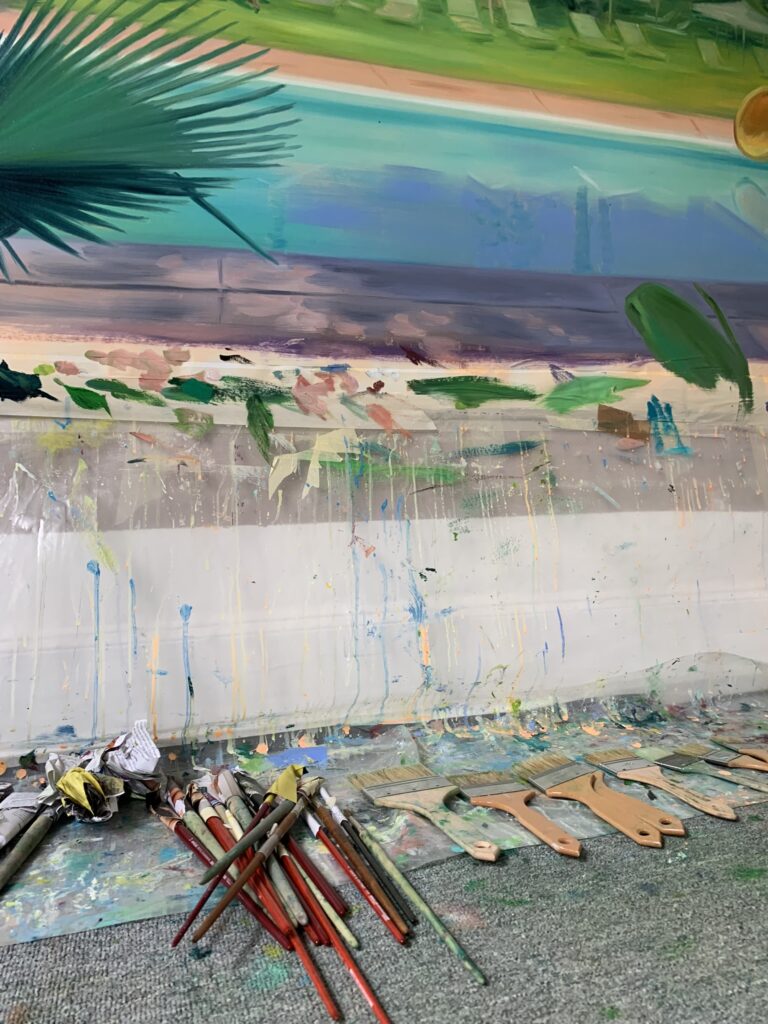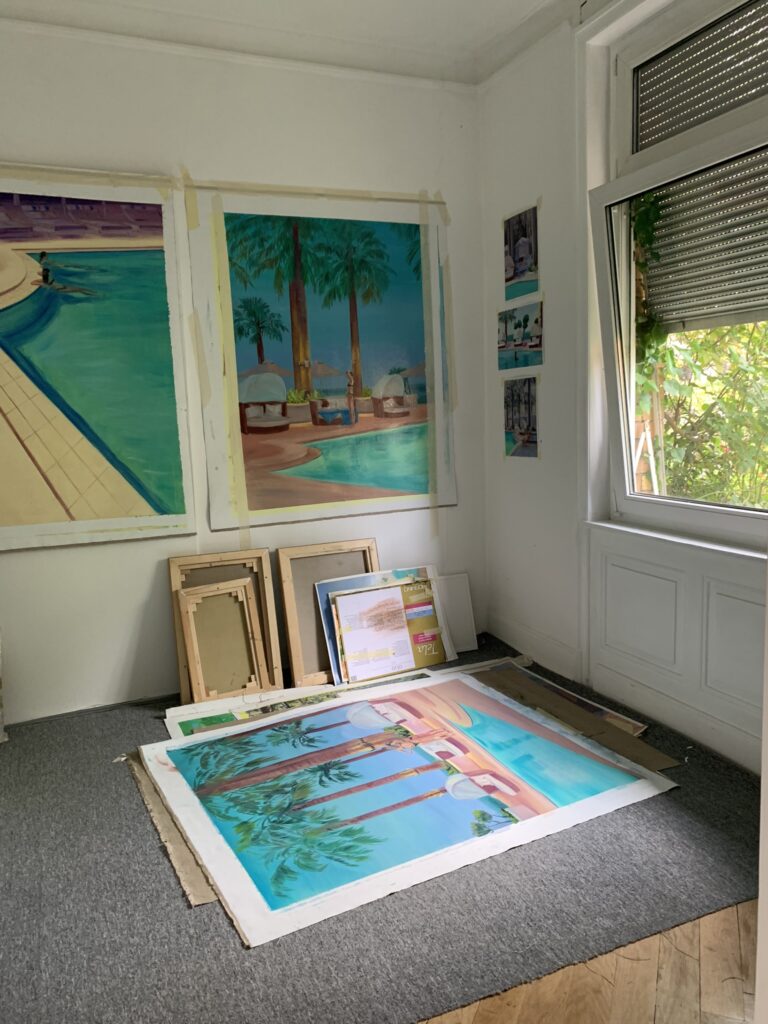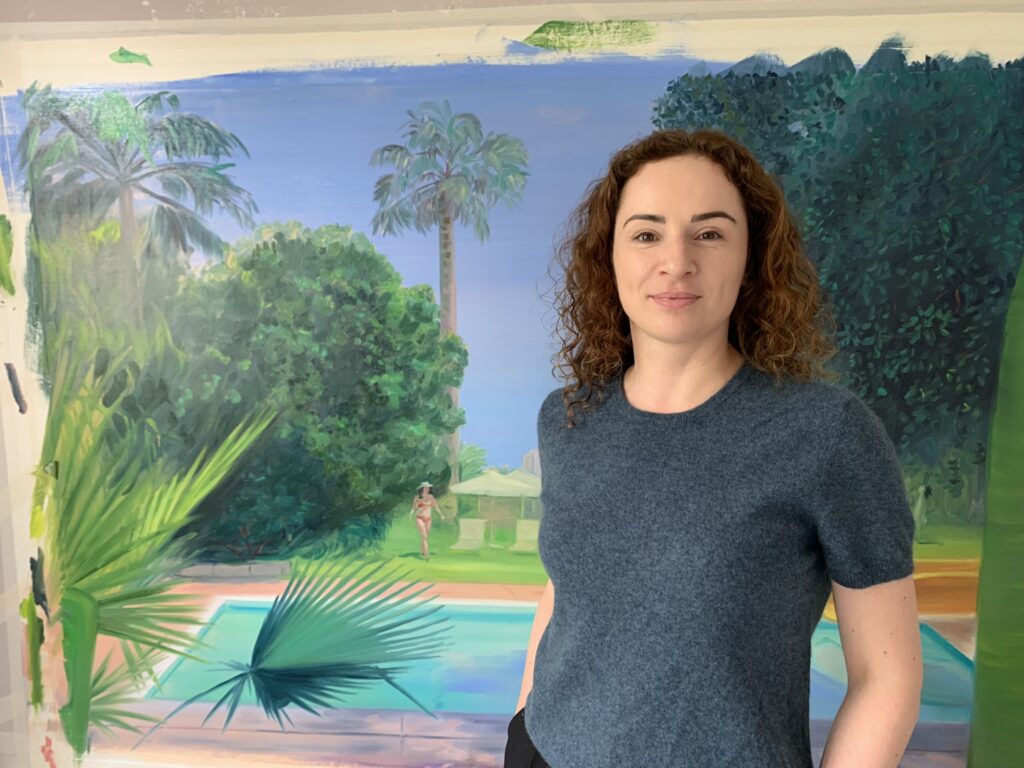A Glimpse into the Creative Sanctuary: A Studio Visit with Carmen Belean
Ilona Keilich, the gallerist, speaks to Carmen at her studio in Stuttgart.
Stepping into the world of an artist is an enchanting experience, an opportunity to witness their creative process first-hand and delve into the inspirations that fuel their artistic endeavors. In this article, we embark on a virtual journey to the studio of our gallery artist Carmen Belean, where we explore their creative sanctuary and gain insights into her artistic practice. Join us as we immerse ourselves in the artist’s world and uncover the secrets that lie within their captivating artworks.
Entering the Artist’s Studio:
As I step into Carmen Belean’s studio, I am greeted by a myriad of colors, and the unmistakable scent of paint. The studio is a treasure trove of artistic materials, from brushes and palettes to tubes of paint and books. The space exudes a sense of organized chaos, with works-in-progress adorning the walls and scattered art supplies hinting at a flurry of creative activity.
The artist’s workspace reveals a glimpse into their process, offering clues about the techniques and mediums they employ. Belean stretches canvases directly on the walls of her studio. She seldom uses stretchers or easels to paint. It creates a feeling of murals or frescoes painted straight on the walls. The artist keeps finished pieces on show, neatly structured one next to the other which brings the atmosphere of the studio to the theme of the painted series.
The artworks speak with one another and generate an artistic ether that inspires Belean to bring out her inner inspiration.

How does your studio space contribute to your creative process? What elements or features are essential for your artistic practice?
The studio space is one of the essential aspects of my life. I am now working in between two studios: I have my old one in Cluj, an old print factory space converted into working space and the one here in Stuttgart, in a beautiful neoclassical building. I was also wondering how much the space I am working in influences me. In Cluj I generally tend to have a wider approach to my works, while in Stuttgart, being a slightly smaller place, I tend to be more detailed focused. But overall, it really comes down to feeling able to start working, and they both fit me very well.
Could you share a bit about your journey as an artist? What initially drew you to the world of art, and how has your artistic style evolved over time?
I suppose it all started when, as I kid, I was often sketching on the walls in my room, or even on the bed top. I had a small figure of a woman drawn in pencil at the canvas on my bed top that I kept even when I became a teenager. Then, at age 11, I convinced my parents to enroll me in the Art High School where I stayed until I was 19. From then on, I attended the National Academy of art in Bucharest for one year, then the University of Art and Design in Cluj for another five. After my MA in Painting and Graphic Art, I left Cluj to study painting for five years under the tutelage of a Greek painter in his studio in Athens, Greece, working a lot in the observational ‘au premier coup’ style, from nature: still life, landscape, figure painting. In 2011 I returned to Cluj to complete my PhD for five years. Later I went back to Athens to join the painting animation Loving Vincent team. It was an interesting project at the time.
Your works display a remarkable command of color. How do you approach color in your compositions, and what role does it play in conveying emotion or narrative within your art?
Color is very important in my practice. In 2018 I returned to Cluj where I started to rent my current studio there. I had about one year of experimenting in grisaille, reducing the palette and working on sculpture motifs, but soon after I realized how deep my need for color and brightness was.
I consider colors as forces, really and I seek to reveal to the fullest the intrinsic power of each color, and that can only work through the right tonal values, they can be transformed by relation: if they work well, the color becomes most effective. I believe that the color is essential in conveying atmosphere and mood.

Can you shed light on the themes or concepts that inspire your artistic exploration? What ideas or subjects fuel your creativity and find their way into your artwork? Why feminine art plays such an important role in your work?
The more I work, the more I am in tune with my inner self. I am a woman and there is a deep need to express my own perception of the world. The identity as a woman comes stronger also in contrast to the male dominated artistic environment that I grew up with. Growing up we hardly had any female artists to look up to. I paint women often but they are always in relation with their surroundings, mostly nature, which is another important aspect of my work, even if this relation can be ambiguous in some of my works.
Many artists have specific rituals or routines they follow before diving into their work. Do you have any unique practices or rituals that help you prepare for a day of creating?
I do take about half an hour before really starting to work in my studio. I need to switch whatever mood I may enter into the studio with, and start approaching the work in progress. This time is usually about preparing my palette for the day or organizing the space around me.
Your compositions often exhibit a captivating sense of relaxation and peace. How do you achieve this state within your artworks, and what techniques or processes do you employ to convey it?
One aspect is, of course, the subject matter. Skill is also very important and although I believe in the purifying or exorcistic power of art, this translates to me by a special level of aesthetic. As my works reveal, I lie on the brighter side of the art spectrum, so to speak. Aesthetics is essential in my life, and therefore I believe in its power. As Matisse put it famously: “I seek to create an art of balance, of purity and serenity devoid of troubling or depressing subject matter.”

Getting inspired by old masters or blue-chip artists is often a driver for young artists. Do you have experienced a similar energy and which artist played such a role in your artistic development?
Old masters and their pristine knowledge of the craft is a constant captivation for me. So are the modern painters, especially the Impressionists and Post-impressionists. I am capable of being very emotional in front of a work of art, and this emotion is something I seek to convey through my own work as well.
What challenges do you encounter during the creative process, and how do you navigate them? Are there any particular moments or techniques that have been instrumental in overcoming creative blocks?
There is an array of various difficulties, always. It is not really hard to do certain things, once you already have the skill, but it is often hard to put yourself in the right state. There are paintings done in five hours, in a very open and loose approach, and others that take months to get right. At another level, the capacity of being attentive, receptive and effective in painting is constantly fluctuating. I have learned, when I have a low level of energy to accept it and maybe even stop working, and to use time for other, less demanding things like preparing my compositions or selecting my subjects. I believe that one cannot have a constant level of focused attention for very long periods of time.
Looking at your body of work, it’s evident that there is a distinctive artistic voice that resonates throughout. How would you describe your artistic voice or vision, and how do you aim to communicate it to your audience?
The inner voice gets clearer and sharper with the time spent in discovering it, it is really magic. First you start with a wish to paint, or some sort of need for it, and then it becomes like an antenna, capturing all impressions and translating them into the painting language. I think that the more this voice becomes authentic, the more people respond to it.
As a successful artist, what advice would you give to aspiring artists who are just beginning their creative journeys?
I believe in work. The only advice I could ever give in full confidence is work as hard as you can, and then even harder.

Leaving the artist’s studio, I carry with me a renewed appreciation for the creative process and the dedication that goes into each brushstroke. My visit has provided a glimpse into the inner workings of Belean’s artistic practice, allowing me to better understand the motivations, inspirations, and techniques that shape her captivating artworks. Through this encounter, I have been reminded of the transformative power of art and the endless possibilities that emerge within the sacred space of an artist’s studio.
Belean’s works continue to inspire and captivate, beckoning to explore our own creative realms and forge a deeper connection with the world of art. As I bid farewell to the studio, I carry the artist’s words, visions, and brushstrokes in my mind, eager to witness the evolution of her artistic journey and the wonders that await on the canvas of their imagination.
A solo exhibition of Carmen Belean’s artistic world will launch at EXOgallery in November later this year.
